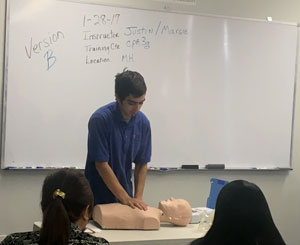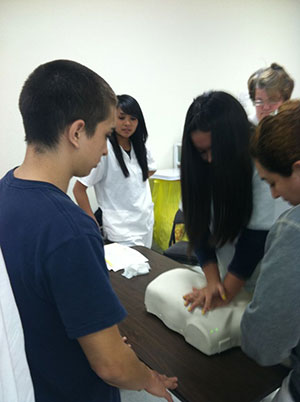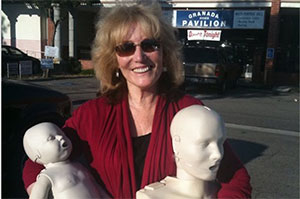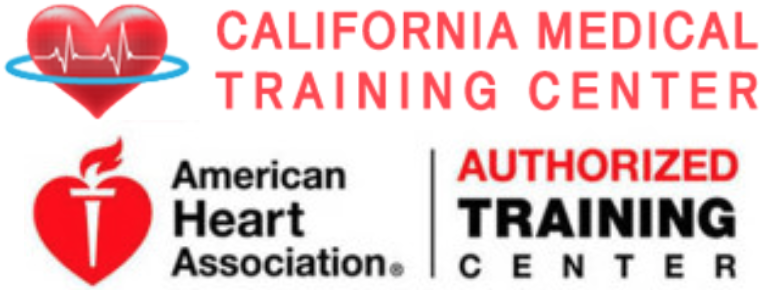CPR/BLS Study Guide
American Heart Association Healthcare Provider Authorized CourseCPR/BLS Certification
$65
CPR/BLS Recertification
$45
CPR/BLS Online
$65
The BLS for Healthcare Provider CPR (Cardiopulmonary Resuscitation/Basic Life Support) course covers CPR skills for all age groups, to include methods of including ventilation, AED use, and FBAO relief in both the responsive and non-responsive victim.
CPR – BLS Study Guide
The below CPR-BLS 2020 Guidelines Summary is for review prior to class, however is not intended as substitute for the Provider Manual
High–quality CPR improves chances of survival for victims.
Characteristics of high-quality CPR include:
• Start compressions within 10 seconds of recognizing cardiac arrest, which is important because it will pump blood to the organs.
• Push hard, push fast at a rate of at least 100-120/minute with a depth of at least 2 inches (5cm) no more than 2.4 inches for adults, 2 inches (5cm) for children, and 1.5 inches (4cm) for infants.
• Allow full chest recoil after each compression to allow the heart to refill with blood after each compression.
• Minimize interruptions in compressions and limit interruptions to less than 10 seconds.
Provide breaths so the chest rises but avoid excessive ventilation.
Age Groups for CPR
Infant age range is birth to 1 year year.
Child age range is 1 year to puberty.
Adult age is considered puberty.
Automated External Defibrillator-AED
• When an AED is available, turn on the AED and use it right away.
• After delivering a shock, immediately restart compressions. Do not check for pulse.
• Adult pads/dose may be used for an infant or a child less than 8 years of age if pediatric pads/dose with an energy dose attenuator is not available.
• Child pads are to be used for victims 1 year to 8 years of age when using an AED
Foreign Body Airway Obstruction – Choking
Performing abdominal thrusts is the best method for relieving severe choking in a responsive adult or child
If the adult or child becomes unresponsive start CPR with compressions and activate the emergency response system.
• To relieve severe choking in a responsive infant: 5 back slaps, followed by 5 chest thrusts. Repeat until dislodged.
• Unresponsive victim of foreign-body airway obstruction: (all age groups) the rescuer should designate someone to activate emergency response system, and then start CPR beginning with compressions.
Child or Infant With A Pulse
• When a child/infant has a pulse of more than 60/minute but is not breathing, the rescuer should give breaths without chest compressions.
• When a child/infant is unresponsive and has a pulse of less than 60/minute but is not breathing with signs of poor circulation despite ventilation and oxygenation with a bag-mask, the rescuer should perform CPR (both compressions and breaths).
C-A-B is Compressions–Airway–Breaths, Not A-B-C
Compressions
• The rescuer should initially ensure that the scene is safe when the rescuer first sees a potential victim.
• A victim who is unresponsive with no normal breathing and no pulse requires CPR.
• It is appropriate to move an adult victim who needs CPR when the victim is in a dangerous environment.
• To identify cardiac arrest in an unresponsive victim with no breathing (or no normal breathing), a healthcare provider should check a pulse for no more than 10 seconds.
• Adult and child pulse is located on the side of the neck, near the trachea
• Infant pulse is located on the inside of the upper arm, between the elbow and the shoulder.
• It is important to compress to the appropriate depth during CPR to create blood flow during compressions.
• The depth of chest compressions for an adult victim should be at least 2 inches (5cm) no more than 2.4 inches.
• The depth of chest compressions for an infant is at least one-third the depth of the chest, approximately 11⁄2 or 1.5 inches (4cm).
• Recommended rate for performing chest compressions for victims of all ages is at least 100-120 compressions per minute.
• Hands are placed on the lower half of the breastbone to perform chest compressions on an adult.
• In 2-rescuer CPR, one rescuer provides chest compressions; the second rescuer maintains an open airway and gives breaths.
The preferred technique for providing chest compressions during 2-rescuer CPR for the infant is the 2 thumb-encircling hands technique.
Airway
• The best way to open the airway of an unresponsive victim with no suspected neck injury is the head tilt-chin lift.
• After the airway is opened, the proper technique for delivering mouth-to-mouth ventilation is the rescuer opens the airway, seals his or her mouth over the victim’s mouth, pinches the victim’s nose closed and gives 2 breaths while watching for the chest to rise.
Breaths
• Bag-mask device/technique is not recommended for a single rescuer to provide breaths during CPR.
• The rescue breath for an adult, child, or infant is effective when the chest rises visibly.
• During bag-mask ventilation, giving a breath just until you see the chest rise is recommended to minimize the risk of air entering the victim’s stomach (gastric inflation).
• The compression- ventilation ratio for 1-rescuer adult CPR and 2-rescuer adult CPR is 30:2.
• The compression- ventilation ratio for 2-rescuer child CPR is 15:2.
• The compression- ventilation ratio for 2-rescuer infant CPR is 15:2.
• Compression and ventilation rates for 2-rescuer CPR in the presence of an advanced airway are to compress at a rate of at least 100-120 per minute, 1 breath every 6 seconds.
• When administering breaths by using a bag-mask device for a child who is not breathing but does have a pulse, the rescuer should give breaths at the rate of 1 breath every 2 to 3 seconds.
The authors make no claims of the accuracy of the information contained herein, and these suggested doses/interventions are not a substitute for clinical judgment. CPR 4G INC is not liable for any special, consequential, or exemplary damages resulting in whole or part from any user’s use of or reliance upon this material. The information provided herein may or may not contain the most current guidelines. Refer to the AHA ECC Guidelines for more details and/or clarification in regards to the most current clinical guidelines.








